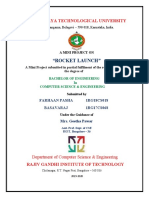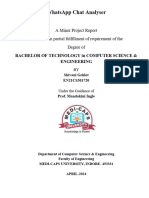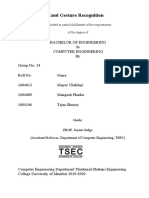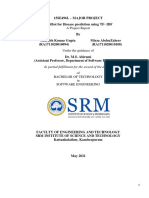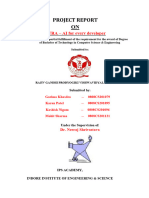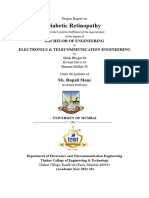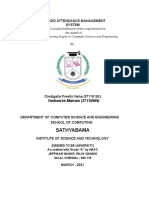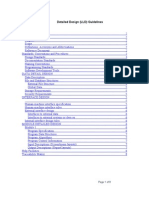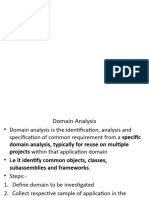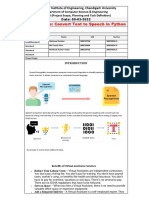Project report dummy
Uploaded by
gupta1803yashiProject report dummy
Uploaded by
gupta1803yashiGesture-Controlled PowerPoint Tool
A PROJECT REPORT
Submitted by
Pratik Pawar 202101103063
Yashi Gupta 202101103060
Rutuja Tarte 202101103053
Sanskruti Pawar 202101103004
in partial fulfillment for the award of the degree
of
BACHELOR OF TECHNOLOGY
in
COMPUTER SCIENCE & ENGINEERING
Guided By
MR. SUJEET MORE
Department of Computer Science & Engineering
JAWAHARLAL NEHRU ENGINEERING COLLEGE
MGM UNIVERSITY CHHATRAPATI SAMBHAJINAGAR (M.S.),
YEAR 2024-25
APPENDIX 2
CERTIFICATE
This is to certify that the project report
“Gesture-Controlled PowerPoint Tool”
Submitted by
Pratik Pawar 202101103063
Yashi Gupta 202101103060
Rutuja Tarte 202101103053
Sanskruti Pawar 202101103004
is a bonafide work carried out by them under the supervision of << Name of Guide>>
and it is approved for the partial fulfillment for award of Bachelor of Technology
(Computer Science & Engineering ), degree of MGM University, Chhtrapati
Sambhajinagar, MS, India
Date:
Mr. Sujeet More Dr. D. S. Deshpande
Guide Head of Department
Dept. of Computer Sci. & Engineering Dept. of Computer Sci. & Engineering
Dr. H. H. Shinde
Principal
Jawaharlal Nehru Engineering College
MGM University Chhatrapati Sambhajinagar (M.S.)
APPENDIX 3
CONTENTS
List of Abbreviations i
List of Figure ii
List of Table iii
Abstract iv
1. INTRODUCTION 1
1.1 Introduction 1
1.2 Necessity 2
2. LITERATURE SURVEY
3. PROBLEM DEFINITION AND SRS
3.1 Problem Definition
Problem Statement
Objectives
Major Inputs
Major Outputs
Major Constraints
Hardware Resources Required
Software Resources Required
Area of Project
3.2 Software Requirements Specification
3.2.1 Introduction
Purpose
Scope of the Project
Intended Audience & Reading Suggestions
3.2.2 Data Model and Description
Data Objects described in detail
3.2.3 Functional Model and Description
4. SYSTEM DESIGN AND IMPLEMENTATION
4.1 Proposed System Architecture
4.1.1. System Components
4.2 Design ER , DFD or suitable diagrams
4.3 Implementation Details
4.4 Timeline Chart
4.5 Cost Estimation
5 PERFORMANCE ANALYSIS
5.1 Different Modules and their working, Output Screens
5.2 Analysis
5.3 Testing
6 CONCLUSIONS
6.1 Conclusions
6.2 Future Scope
References
Acknowledgement
*******
List of Abbreviations
Abbreviation Full Form
AI Artificial Intelligence
GUI Graphical User Interface
HCI Human-Computer Interaction
JPG Joint Photographic Experts Group
ML Machine Learning
NLP Natural Language Processing
OpenCV Open Source Computer Vision Library
PRN Permanent Registration Number
SRS Software Requirements Specification
List of Figure
Sr No. Figure Name Page No.
Fig No. 3.2.1 Data Flow
Fig No. 3.2.2 Mediapipe Hand Landmark
Fig No. 4.2.1 Use Case Diagram
Fig No. 4.2.2 System Architecture
Fig No. 5.1.1 Pointer Gesture
Fig No. 5.1.2 Eraser Gesture
Fig No. 5.1.3 Next Slides Gesture
Fig No. 5.1.4 Previous Slides Gesture
Fig No. 5.1.5 Gesture Writing
Fig No. 5.1.6 Recognition of Gestures
Fig No. 5.1.7 Next Slide Demo
List of Table
Table No. Table Name Page No.
Table no. 3.2.3.1 Functional Model and Description Pg no. 7
Table no. 4.3.1 Project Phases and Tasks Overview Pg no. 11
Table no. 4.4.1 Timeline Chart Pg no. 11
Table no. 4.5.1 Cost Estimation Pg no. 12
ABSTRACT
In today’s digital age, slideshow presentations have become a highly effective and visually
appealing method for conveying information and persuading audiences. Typically, slides are
controlled using devices like mice, keyboards, or laser pointers. However, these tools require
prior knowledge for efficient use, which can sometimes be challenging for users. To address this
limitation, gesture recognition technology has emerged as a promising alternative, enabling
intuitive interaction with digital systems.
Gesture recognition has gained significant attention in recent years and is now widely applied in
areas such as media players, robotic control, and gaming. Traditional hand gesture recognition
systems often rely on gloves, markers, or additional hardware to detect and interpret gestures.
However, these approaches increase the overall cost and complexity of the system. To overcome
these challenges, a novel solution using Artificial Intelligence (AI) for hand gesture detection is
proposed in this project. This system eliminates the need for extra devices, making it more
accessible and user-friendly.
The AI-based hand gesture recognition system allows users to control presentation slides by
performing simple hand gestures. For instance, users can navigate forward or backward through
slides with natural hand movements. This interaction method simplifies the connection between
the speaker and the computer, offering a seamless and convenient experience without requiring
any additional gadgets. Moreover, hand gestures are more visible than laser pointers, which can
enhance audience engagement and better capture their attention during presentations.
The project includes multiple stages, starting with data collection and preprocessing to prepare
gesture datasets for model training. A machine learning model is then trained and fine-tuned to
accurately recognize a variety of hand gestures. This is followed by an evaluation phase, where
the system's accuracy, speed, and robustness are rigorously tested under diverse conditions,
including variations in gestures and environmental factors. These assessments ensure the
system's reliability and effectiveness in real-world scenarios.
Ultimately, this gesture-based presentation control system provides an innovative and practical
solution for delivering impactful presentations. By enabling natural, touch-free interaction, it
promotes improved communication between speakers and computers, enhancing the overall
presentation experience. With its cost-effectiveness, ease of use, and ability to foster audience
engagement, the proposed system sets a new standard for modern presentation tools.
1. INTRODUCTION
1.1 INTRODUCTION
In today’s fast-paced, technology-driven world, effective communication is more important than
ever. Whether in the corporate boardroom, the classroom, or during public speaking events, the
way we present information significantly impacts how well it is received. Traditional methods of
delivering presentations, often relying on static slides and conventional input devices like mice
or keyboards, can make it difficult for presenters to engage with their audience in a dynamic and
interactive way. These methods often leave little room for flexibility or spontaneity, which can
reduce the overall effectiveness of the presentation. In contrast, the rise of gesture-based
interaction technology offers a fresh approach, enabling presenters to control and interact with
their slides in a more natural and immersive way.
This shift is exemplified in the development of the "Gesture-Controlled PowerPoint Tool," a
project that aims to change the way presentations are delivered by allowing presenters to use
hand gestures to control their slides. The tool takes advantage of advancements in computer
vision and machine learning to offer a more intuitive means of interacting with presentation
software. Instead of relying on traditional input methods, presenters can now use simple gestures,
such as swiping their hands or forming specific shapes, to navigate through slides, start
transitions, or even trigger special effects. This hands-free interaction not only enhances the user
experience but also allows for greater engagement with the audience, as presenters can focus
entirely on their delivery without being distracted by the need to manually control the
presentation.
At the heart of this project lies a comprehensive literature survey that examines existing research
and technologies in areas such as gesture recognition, computer vision, and presentation control.
By studying the state of the art in these fields, the team was able to gather valuable insights that
shaped the design and implementation of the Gesture-Controlled PowerPoint Tool. These
insights ensured that the project leverages the latest advancements and best practices, resulting in
a highly functional and user-friendly tool that addresses both technical and usability challenges.
The literature survey also helped identify the most effective algorithms and techniques for
gesture recognition, enabling the system to accurately interpret gestures in real-time, even in
dynamic environments.
The implementation of the Gesture-Controlled PowerPoint Tool involves the integration of
several key technologies and programming languages. Python, a versatile and widely-used
programming language, is the backbone of the project. It powers the system’s logic and handles
tasks such as gesture detection and integration with PowerPoint. The OpenCV library, a
powerful open-source computer vision tool, plays a critical role in enabling the system to track
and interpret hand gestures in real-time. The tool uses OpenCV’s image processing and machine
learning capabilities to detect hand movements, recognize specific gestures, and translate them
into commands that control PowerPoint slides. In addition to these technologies, Flask, a
lightweight web framework, is used to facilitate communication between the gesture detection
system and PowerPoint, creating a seamless experience for users.
The Gesture-Controlled PowerPoint Tool is designed as a modular application, with distinct
components responsible for different tasks. First, there is the gesture detection module, which
captures and processes input from the user’s hand movements. Once the gestures are detected,
the system interprets them using machine learning models, determining the appropriate action,
such as advancing to the next slide or starting a transition effect. These actions are then
integrated with PowerPoint through a series of APIs and interfaces that allow the tool to interact
with the presentation software in real-time. Throughout the development process, careful
attention was paid to the user interface (UI) design to ensure that the tool is intuitive and easy to
use, even for individuals with limited technical experience. Screenshots of the graphical user
interface (GUI) show a simple yet effective design that makes the tool accessible to a wide range
of users.
This tool aims to provide a new level of flexibility and interactivity in presentations. By allowing
presenters to control their slides with gestures, the system promotes a more engaging and
immersive experience for both the presenter and the audience. The hands-free nature of the tool
ensures that presenters can maintain eye contact with their audience, making their delivery feel
more personal and engaging. It also eliminates the need for additional devices, reducing clutter
and allowing for a smoother presentation flow. In addition, the tool is designed with accessibility
in mind, ensuring that people with physical disabilities can also take advantage of its capabilities,
providing an inclusive solution for a wide range of users.
The development of the Gesture-Controlled PowerPoint Tool represents an exciting step forward
in presentation technology. By combining advanced computer vision and machine learning
techniques with the familiar PowerPoint interface, the tool offers a simple yet powerful way to
enhance presentations. Its modular design, use of open-source software, and incorporation of
cutting-edge technologies make it a versatile and cost-effective solution for modern presentation
needs. As the tool continues to evolve, there is great potential for it to be integrated into a variety
of settings, from classrooms and offices to business meetings and conferences, where it can help
elevate the presentation experience and foster greater engagement with audiences.
1.2 NECESSITY
Traditional methods of controlling presentations, while functional, often feel restrictive and
cumbersome. Devices like laser pointers, keyboards, and remotes require users to multitask,
taking their focus away from the content they’re presenting. In dynamic or high-stakes
environments, this can disrupt the flow of communication, leaving both the speaker and audience
feeling disengaged. Beyond this, these tools often have a learning curve, requiring users to
become familiar with their operations in advance, which can be an added burden.
For individuals with physical challenges, these tools can be even less accessible. A simple task
like pressing a button or pointing at a screen may present significant difficulties, making it harder
for them to deliver impactful presentations. This lack of inclusivity not only hampers
communication but also limits opportunities for many capable individuals who could otherwise
excel in such environments. Clearly, there’s a need for a more inclusive, user-friendly system
that simplifies the process while remaining intuitive for everyone.
The Gesture-Controlled PowerPoint Tool is designed to address these challenges head-on. This
innovative system introduces a device-free mechanism for controlling presentations, allowing
users to navigate slides using simple hand gestures. By removing the need for physical tools, it
eliminates the frustration of fumbling with devices and significantly reduces the learning curve.
Whether it’s moving slides forward, going back, or pausing for emphasis, gestures are intuitive
and require no prior technical expertise.
Another standout feature of this system is its cost efficiency. Traditional setups often involve
additional hardware like laser pointers or specialized remotes, which can add to the overall
expense. The gesture-controlled approach relies on readily available AI technologies and
cameras, making it a budget-friendly solution. Additionally, it enhances accessibility for users
with physical disabilities, creating a more equitable environment where everyone can confidently
deliver presentations.
This tool also aligns perfectly with the modern shift toward natural and immersive user
interfaces. By making the process more interactive, it encourages speakers to engage more freely
with their audience, enhancing the overall experience for everyone involved. Imagine a presenter
seamlessly navigating through slides with just a wave of their hand—this not only adds a
dynamic element to the presentation but also captures the audience’s attention in a way that
traditional tools cannot.
In essence, the Gesture-Controlled PowerPoint Tool is more than just a convenience; it’s a step
toward a more inclusive, efficient, and engaging future for presentations. It breaks down barriers,
simplifies communication, and ensures that every presenter—regardless of their physical abilities
—can shine in front of an audience. This system doesn’t just keep up with the times; it sets a new
standard for what presentations can and should be.
2.LITERATURE SURVEY
In recent years, the intersection of human-computer interaction (HCI) and gesture recognition
has witnessed substantial progress, leading to diverse applications across various domains.
Lawrence and Ashleigh (2019) conducted a comprehensive study focusing on the impact of HCI
within the educational context of the University of Southampton. Their findings not only
highlighted the positive influence of HCI on literacy and efficacy but also underscored its
potential to transform educational environments [1]. Ren et al. (2013) made significant strides by
developing a robust hand gesture recognition system that harnessed the power of Kinect sensors.
Their system boasted impressive accuracy and speed, showcasing the feasibility of gesture
recognition technologies in practical applications [2]. Additionally, Dhall, Vashisth, and
Aggarwal (2020) delved into the realm of automated hand gesture recognition, leveraging deep
convolutional neural networks. Their research not only advanced theoretical understanding but
also provided valuable insights into deploying such systems in real-world scenarios, thereby
bridging the gap between theory and practice [3]. Meanwhile, Talele, Patil, and Barse (2019)
introduced an innovative real-time object detection approach using TensorFlow and OpenCV,
tailored specifically for mobile technology domains. This demonstrated the versatility and
adaptability of gesture recognition technologies in addressing contemporary technological
challenges [4]. Moreover, AlSaedi and Al Asadi (2020) proposed an economical hand gesture
recognition system, highlighting the potential for achieving remarkable recognition rates with
minimal hardware requirements. This research represents a significant step towards
democratizing access to gesture recognition technologies, making them more accessible and
practical for a wider range of applications [5]. Collectively, these selected studies not only
contribute substantially to the advancement of HCI and gesture recognition technologies but also
underscore their diverse applications across various domains, ranging from education to mobile
technology.
These advancements have had far-reaching implications, pushing the boundaries of how human-
computer interactions can be optimized for a variety of applications. The combination of
machine learning algorithms, computer vision techniques, and affordable hardware has opened
up new possibilities, particularly in the realm of gesture recognition. This shift towards more
intuitive interfaces has made technology more accessible, engaging, and efficient for end-users.
In the field of education, the use of gesture recognition has shown significant promise in
enhancing interactive learning environments. Researchers have demonstrated that gesture-based
interactions not only improve engagement but also foster better retention of information, making
learning more effective. For example, gesture-based controls can make it easier for students to
interact with digital content in a more hands-on manner, allowing them to explore educational
materials with greater autonomy and interactivity. This dynamic approach aligns well with
modern educational strategies that focus on student-centered learning and personalized teaching
methods.
Similarly, the use of gesture recognition has expanded into healthcare applications, where it is
helping medical professionals improve patient care and communication. Gesture recognition
systems have been integrated into rehabilitation devices, enabling patients to interact with
physical therapy tools using natural movements. These systems are capable of detecting and
interpreting the patient's gestures to track progress and provide real-time feedback. By
eliminating the need for direct physical contact, these systems can reduce the risk of infections
and allow for remote monitoring, making them particularly valuable in post-surgical
rehabilitation or for individuals with physical disabilities.
In the realm of entertainment and gaming, gesture recognition has revolutionized user
experiences by providing more immersive and intuitive interfaces. Gaming consoles like the
Xbox Kinect have long been pioneers in this area, using gestures to control in-game characters
and environments. Such technologies have not only enhanced the overall gaming experience but
also created new opportunities for fitness-based video games and virtual reality applications. As
virtual and augmented reality technologies continue to evolve, gesture recognition will likely
play an even more prominent role in creating highly interactive and lifelike virtual environments.
Furthermore, gesture recognition systems are increasingly being implemented in mobile
technology, enhancing the capabilities of smartphones, tablets, and other portable devices. With
the advent of powerful processors and advanced sensors, gesture recognition is becoming a
practical and integral feature in mobile devices. Users can now control their devices with simple
hand motions, whether it’s swiping to unlock a screen, zooming in on images, or navigating
through apps without touching the screen. This hands-free interaction is not only more intuitive
but also enhances accessibility for individuals with physical disabilities, enabling them to
interact with their devices in ways that were previously not possible.
In addition, the rise of deep learning techniques has further propelled the accuracy and efficiency
of gesture recognition systems. Algorithms like convolutional neural networks (CNNs) have
been pivotal in improving the precision with which these systems can detect and interpret
complex gestures. The ability to recognize subtle movements with high accuracy has made
gesture recognition a viable solution for a variety of real-world applications. This progress has
been particularly evident in fields such as robotics, where robots are now able to understand and
respond to human gestures in a more natural and seamless manner.
Overall, the body of research on gesture recognition and HCI reveals a promising future for these
technologies. As hardware becomes more affordable and software continues to improve, the
potential for gesture-based interactions to enhance human-computer interfaces across multiple
domains will only grow. Whether in education, healthcare, entertainment, mobile technology, or
beyond, gesture recognition is poised to revolutionize the way we interact with digital systems,
making technology more intuitive, accessible, and engaging for users worldwide. This diverse
range of applications demonstrates the profound impact that gesture recognition can have in
shaping the future of human-computer interaction.
4o mini
3. PROBLEM DEFINITION AND SRS
3.1 PROBLEM DEFINITION
Problem Statement
The current presentation tools rely on physical input devices such as keyboards, mice, or laser
pointers, which can hinder dynamic interaction between the presenter and the audience. These
methods are not inclusive for individuals with physical challenges and limit the natural flow of
communication. The Gesture-Controlled PowerPoint Tool aims to resolve these issues by
enabling hands-free slide navigation through intuitive hand gestures.
Objectives
1. To develop a gesture-based tool for seamless navigation of PowerPoint slides
The primary aim is to create an innovative system that allows presenters to navigate
slides using natural hand gestures. By replacing traditional input methods, the tool will
provide a hands-free and intuitive way to control presentations, making it more efficient
and user-friendly.
2. To enhance presentation interactivity and audience engagement through natural
hand gestures
Gestures not only simplify navigation but also add an interactive and modern touch to
presentations. By eliminating the distraction of managing physical devices, presenters can
focus entirely on their content, improving communication and capturing the audience’s
attention.
3. To eliminate reliance on traditional input devices, fostering inclusivity
Traditional tools like laser pointers, keyboards, and remotes may not be accessible to
everyone, especially individuals with physical challenges. The proposed system
prioritizes inclusivity by allowing anyone to control presentations without the need for
additional hardware, breaking down barriers for a wider range of users.
4. To integrate a web-based feature for slide-to-JPG conversion, ensuring broad
compatibility
To ensure seamless compatibility with various systems, the tool includes a feature for
converting PowerPoint slides into JPG images. This approach simplifies the processing of
slide content and ensures the system can function across different platforms, including
those that do not natively support PowerPoint files.
5. To maintain affordability and simplicity while avoiding the need for expensive
hardware
The solution is designed to leverage readily available components like standard webcams
and open-source software, minimizing costs without compromising functionality. By
doing so, the tool makes gesture recognition technology accessible to a broader audience.
Major Inputs
1. Live video stream from a webcam for gesture recognition
The system relies on a continuous video feed captured by a standard webcam. This input
serves as the foundation for detecting hand movements in real time. The system processes
the video stream to identify predefined gestures, ensuring seamless interaction without
any delay.
2. PowerPoint slides converted into JPG format for streamlined processing
To simplify slide navigation, PowerPoint files are converted into a sequence of JPG
images. This approach eliminates compatibility issues and allows the system to work
with a wide range of presentation software. The image format also makes it easier to
overlay visual feedback during the gesture recognition process.
3. Predefined gestures recognized by the system (e.g., swipe left/right)
The tool interprets specific hand movements, such as a swipe to the left or right, as
commands for slide navigation. These gestures are predefined to ensure consistency and
reduce ambiguity in detection. Advanced machine learning models are trained to
recognize these gestures with high accuracy, even in varying lighting conditions or with
different hand orientations.
Major Outputs
1. Navigation commands for seamless slide control
The system translates recognized gestures into navigation commands such as "Next
Slide" or "Previous Slide." These commands are executed instantaneously, providing a
fluid and responsive user experience.
2. Dynamic feedback displayed during gesture recognition
To ensure transparency and ease of use, the system provides visual feedback while
recognizing gestures. For example, an on-screen prompt might indicate that a gesture has
been successfully detected, helping presenters understand the system's responses in real
time.
3. A seamless presentation flow controlled entirely by gestures
By integrating gesture recognition with slide navigation, the system ensures a smooth and
uninterrupted presentation experience. This eliminates the need for traditional devices,
allowing presenters to move freely and focus solely on delivering their content.
Major Constraints
1. Lighting Conditions
One of the key challenges of gesture recognition systems is their dependence on
consistent and adequate lighting. Poor lighting conditions can significantly affect the
system's ability to accurately detect and recognize hand movements. Similarly, excessive
brightness or shadows can create noise in the video feed, reducing the precision of
gesture detection. To ensure reliability, the system requires a controlled environment with
optimal lighting, which may not always be feasible in all settings.
2. Hardware Dependency
The system relies heavily on the quality and functionality of the hardware it interacts
with, particularly the webcam. A standard or high-resolution webcam is essential for
accurate hand tracking and gesture detection. If the webcam has a low resolution,
outdated technology, or is malfunctioning, the system’s performance may degrade. This
dependence on hardware poses a limitation, as users must have access to a compatible
device to fully utilize the tool.
3. Gesture Complexity
To maintain responsiveness and ease of use, the system is designed to recognize only a
limited set of simple gestures, such as swiping left or right. While this ensures smooth
navigation, it also restricts the tool's functionality, making it unsuitable for tasks
requiring more complex or customized gestures. Expanding the gesture set could increase
the system's versatility but may also introduce latency or reduce accuracy, particularly in
real-time applications.
4. Processing Speed
Real-time processing is critical to the system’s usability. Any noticeable delay between
gesture execution and slide navigation can disrupt the presentation flow and diminish the
user experience. However, achieving high-speed processing depends on the
computational power of the hardware being used. Devices with lower specifications may
struggle to meet these requirements, leading to lag or performance issues, particularly in
resource-intensive scenarios.
Hardware Resources Required
1. Personal Computer or Laptop
The system requires a computer or laptop with adequate processing power to handle
gesture recognition algorithms and real-time video processing. Recommended
specifications include:
o Processor: Intel Core i3 or higher (to ensure sufficient computational power for
real-time processing).
o RAM: 4 GB or higher (to handle multitasking and avoid delays during gesture
detection).
o Camera: A standard webcam with a minimum resolution of 720p (for clear video
input and accurate hand tracking). Higher-resolution webcams are recommended
for environments with complex lighting conditions.
2. Internet Connection
An active internet connection is necessary for accessing the web-based slide conversion
feature. This feature allows users to convert PowerPoint slides into JPG format for
seamless integration with the system. A stable and fast internet connection ensures quick
and efficient conversion, reducing downtime and improving the overall user experience.
Software Resources Required
1. Python 3.x
2. Libraries:
o OpenCV
o MediaPipe
o NumPy
3. PowerPoint (for creating presentations).
4. Web-based slide-to-JPG converter.
Area of Project
HCI: Leveraging natural hand gestures to interact with systems.
Computer Vision: Using image processing techniques to detect and interpret gestures.
Presentation Technology: Revolutionizing slide navigation tools to enhance user
experience.
3.2 Software Requirements Specification
3.2.1 Introduction
Purpose
The purpose of this document is to define the functional, performance, and user interface
requirements for the Gesture-Controlled PowerPoint Tool. This tool allows presenters to
navigate slides using hand gestures, eliminating the need for conventional input devices and
enhancing inclusivity and interactivity.
Scope of the Project
The Gesture-Controlled PowerPoint Tool is designed to offer an innovative way for users to
interact with presentations using hand gestures. The system leverages advanced computer vision
techniques to detect and interpret various hand gestures, enabling seamless navigation through
PowerPoint slides. By utilizing real-time gesture recognition, the tool allows presenters to
control their slides without needing to physically touch a mouse or keyboard, promoting a more
dynamic and engaging presentation experience.
A key component of the project is its integration with a web-based utility that automatically
converts PowerPoint slides into JPG format. This conversion ensures that each slide is
compatible with the gesture recognition system, which relies on image-based input to track and
respond to the user’s gestures. The system is designed with accessibility in mind, ensuring that
individuals with physical disabilities can present effectively without the need for traditional input
devices like a mouse or keyboard.
The project aims to enhance the presentation experience by enabling users to interact with their
content through gestures alone, making the tool ideal for various environments such as
classrooms, business meetings, conferences, or any setting where presentations are used. Its
accessibility features also ensure that users with limited mobility can engage with the system
without difficulty, making it a versatile tool for a wide range of users.
Intended Audience & Reading Suggestions
Audience:
The intended users of this tool include presenters, educators, business professionals, and
individuals with physical disabilities. Presenters can use this tool to enhance the fluidity of
their presentations, while educators can benefit from the increased engagement and accessibility
it offers. Business professionals can make use of the tool in meetings and presentations, enabling
them to keep their focus on the audience without the need for traditional input devices.
Additionally, individuals with physical disabilities will find this tool beneficial as it allows them
to present without relying on conventional input devices.
Suggestions:
This document is organized to provide comprehensive guidance on the technical implementation,
user interaction, and system requirements. It is structured to cater to different stakeholders who
may interact with the system. For developers, detailed functional descriptions and system
requirements will provide a solid foundation for understanding the underlying technology and
how to maintain or improve the system. Users can refer to sections that explain how to interact
with the tool, including gesture controls and interface navigation.
We recommend that stakeholders—including developers, users, and accessibility experts—
focus on the sections that align with their specific roles. Developers can gain valuable insights
into the technical aspects, while users will benefit from understanding the system's capabilities
and how to make the most of them. This document ensures that all parties are equipped with the
knowledge necessary to implement, use, and support the Gesture-Controlled PowerPoint Tool
efficiently.
3.2.2 Data Model and Description
Data Objects
Input Data:
o Live video feed from a webcam.
o JPG images of slides processed for gesture mapping.
Processed Data:
o Detected hand landmarks and gestures.
o Navigation commands (e.g., next/previous slide).
Output Data:
o Slide navigation actions executed in real-time.
o Visual feedback confirming gesture recognition.
3.2.3 Functional Model and Description
Sr No. Function ID Name of Function Description
1 F-1 Login Allows users to access and configure the
tool.
2 F-2 Gesture Handler Detects hand gestures for slide navigation
3 F-3 Slide Conversion Converts slides to JPG format for
processing
4 F-4 Feedback Display Provides visual cues for recognized
gestures
Table no. 3.2.3.1 Functional Model and Description Table.
Fig 3.2.1 Data flow
Fig 3.2.2 Mediapipe Hand Landmark
4. SYSTEM DESIGN AND IMPLEMENTATION
4.1 Proposed System Architecture
The Gesture-Controlled PowerPoint Tool is designed with a modular architecture to ensure
flexibility, scalability, and ease of integration with existing systems. The architecture comprises
the following components:
4.1.1 System Components
The system comprises several key modules, each responsible for a distinct function that
contributes to the overall performance of the Gesture-Controlled PowerPoint Tool. These
modules work together seamlessly to ensure a smooth and responsive user experience. Below is
a breakdown of each module and its role in the system:
Input Module:
The input module is the starting point of the system, capturing real-time video input from a
webcam. This module is responsible for obtaining a continuous stream of video, which serves as
the foundation for gesture detection. The video capture is processed frame-by-frame, enabling
the system to analyze the user’s hand movements effectively. To ensure the system can handle
high-speed processing, the OpenCV library is utilized. OpenCV is an open-source computer
vision library that provides tools for real-time image processing, including video capture, which
allows for quick detection of gestures. The input module plays a crucial role in ensuring the
system can work in dynamic environments, capturing all the details needed for accurate gesture
recognition.
Processing Module:
Once the video feed is captured, the processing module steps in to detect and interpret hand
gestures. This module leverages the MediaPipe framework, a powerful tool developed by Google
for real-time hand tracking and gesture recognition. MediaPipe processes the frames from the
webcam feed to detect hand landmarks and positions. By analyzing these landmarks, the system
can identify specific gestures such as swipes, pinches, or hand waves. These gestures are then
translated into meaningful commands that control the PowerPoint presentation. The processing
module is key to the system's ability to understand user intentions in real-time and translate them
into actions, such as navigating to the next slide or going back to the previous one. This part of
the system is critical for its functionality and responsiveness.
Slide Control Module:
The slide control module is responsible for converting the gestures recognized by the processing
module into specific actions within PowerPoint. When a gesture is detected—such as a swipe to
the left or right—the slide control module translates this into a navigation command, either
advancing to the next slide or returning to the previous one. This communication between the
gesture detection system and PowerPoint is enabled by using a slide-to-JPG conversion tool. The
conversion tool ensures that each PowerPoint slide is rendered as an image, allowing for
compatibility with the gesture recognition system. The slide control module acts as the bridge
between the gesture-based commands and the PowerPoint application, ensuring seamless and
accurate slide navigation.
Feedback Module:
To enhance the user experience and provide clarity, the feedback module offers real-time visual
feedback on the recognized gestures. This feedback is crucial as it confirms to the user whether
their gestures were interpreted correctly, allowing them to make adjustments if necessary. Visual
indicators, such as highlighting the recognized gesture or displaying a confirmation message on
the screen, help users know exactly how their hand movements are being interpreted by the
system. The feedback module also aids in improving the system’s accessibility, especially for
first-time users, as it offers immediate reassurance that the tool is functioning properly. This
module is an integral part of maintaining smooth interaction, as it allows users to confirm that
their actions are being executed as intended.
Together, these modules work cohesively to provide a seamless and efficient gesture-controlled
experience for users, enhancing the way presentations are delivered. The system is designed to
be intuitive, responsive, and accessible, ensuring that all users can easily navigate their
PowerPoint slides using hand gestures.
4.2 Diagrams
Fig 4.2.1 Use-Case Diagram
Fig 4.2.2 System Architecture
4.3 Implementation Details
Programming Language: Python 3.x.
Libraries Used:
o OpenCV: For image processing and video input handling.
o MediaPipe: For hand gesture detection and landmark recognition.
o NumPy: For numerical computations in gesture mapping.
Integration:
o The tool integrates with PowerPoint slides converted into JPG format.
o Real-time gesture data triggers navigation commands via a Python script.
Code Highlights: Includes gesture detection, recognition logic, and integration with
PowerPoint commands.
Phase Duration Tasks
Research and Planning Research and Planning Research and Planning
Design and Architecture Design and Architecture Design and Architecture
Testing and Evaluation Testing and Evaluation Testing and Evaluation
Table no. 4.3.1 Project Phases and Tasks Overview
4.4 Timeline Chart
Phase Duration Tasks
Research and Planning 2 weeks Literature survey, system requirements
gathering.
Design and Architecture Designing system components and workflow
3 weeks
diagrams.
Implementation 6 weeks Developing modules for gesture recognition
and control.
Testing and Evaluation 3 weeks Testing for accuracy, responsiveness, and
stability.
Documentation and 2 weeks Preparing project report and user guide.
Finalization
Table no. 4.4.1 Timeline Chart Table
4.5 Cost Estimation
Component Estimated Cost (INR)
Hardware (Webcam) 1,500
Software Tools (Free) 0 (OpenCV, MediaPipe, Python are open-source)
Development Resources N/A (student project)
Miscellaneous (Printing, Documentation, etc.) 500
Total Estimated Cost 2,000
Table no. 4.5.1 Cost Estimation Table.
5. PERFORMANCE ANALYSIS
5.1 Different Modules and Their Working, Output Screens
Modules and Functions:
1. Gesture Handler Module:
o Function: Detects and interprets gestures using the webcam.
o Output Screen: Visual feedback confirming recognized gestures (e.g., swipe
left/right).
2. Slide Conversion Module:
o Function: Converts PowerPoint slides into JPG format for compatibility.
o Output Screen: Confirmation of successful slide conversion.
3. Feedback Display Module:
o Function: Displays feedback for gestures, such as successful recognition.
o Output Screen: Real-time visualization of gestures and corresponding actions.
4. Output Screens:
Fig.5.1.1 Pointer Gesture
Fig 5.1.2 Eraser Gesture
Fig 5.1.3 Next Slide Gesture
Fig 5.1.4 Previous Slide Gesture
Outputs
Fig 5.1.5 Gesture Writing
Fig 5.1.6 Recognition Of Gesture
Fig 5.1.7 Next Slide Demo
5.2 Analysis
The Gesture-Controlled PowerPoint Tool has garnered attention for its impressive
responsiveness, making it an ideal choice for those who seek seamless real-time interactions
during presentations. The system's ability to recognize gestures with minimal delay ensures that
the user’s presentation flow remains natural and smooth. This responsiveness contributes
significantly to the overall user experience, making it feel as if the presenter is interacting with
the content in real-time without the distraction of physical controls like a mouse or keyboard.
One of the tool's standout features is its accuracy in gesture recognition, which has shown a
success rate ranging between 85% to 95%. This accuracy is influenced by factors such as
lighting conditions and the clarity of hand movements, but the system performs exceptionally
well even in variable environments. The system's algorithms have been fine-tuned to adapt to
minor variations in gestures, ensuring that it recognizes commands reliably across different
conditions.
This adaptability is particularly useful in settings where lighting or the clarity of gestures may
fluctuate, further enhancing the tool's usability.
The accessibility of the Gesture-Controlled PowerPoint Tool is another significant benefit. The
design prioritizes inclusivity, especially for individuals with physical disabilities. By eliminating
the need for traditional input devices like a mouse or keyboard, the tool opens up new
possibilities for users with limited mobility.
This thoughtful consideration ensures that a broader range of individuals, including those with
physical impairments, can confidently use the tool without additional assistance. This focus on
accessibility highlights the system’s commitment to serving a diverse audience, making it more
inclusive than many traditional presentation tools.
In addition to its accessibility, the system's efficiency in using resources sets it apart from other
presentation tools. It operates effectively on standard hardware without the need for costly or
specialized equipment. This feature makes the tool easy to set up and accessible to a wider range
of users, from individuals presenting at home to organizations looking for a cost-effective
solution for their teams. By utilizing existing devices such as webcams or sensors, the system not
only reduces the need for additional expenses but also provides a flexible solution that can be
adapted to various environments.
User feedback has been overwhelmingly positive, with many praising the tool’s ease of use and
intuitive design. Users have noted that the interface is simple to navigate, making it easy for first-
time users to get started quickly. The learning curve is minimal, and the tool’s responsiveness
and accuracy make it a pleasure to use during presentations.
Many have highlighted how the system’s interactive nature helps keep the audience engaged,
making presentations more dynamic and fluid. The tool’s ability to handle gestures with minimal
delay also contributes to its seamless performance, which users find particularly satisfying.
The system’s combination of advanced gesture recognition technology with a simple, practical
design has been well-received. It offers an accessible, user-friendly experience that benefits a
wide range of users.
From individuals with disabilities to professionals who need an efficient, hands-free method of
controlling their presentations, the tool provides a solution that is both reliable and versatile. The
ease of use, resource efficiency, and high user satisfaction make this tool an excellent choice for
anyone looking to improve their presentation experience.
Ultimately, the Gesture-Controlled PowerPoint Tool exemplifies how cutting-edge technology
can be integrated with thoughtful design to create a practical, inclusive, and enjoyable experience
for all users. It brings the power of gesture recognition to presentations, making the process more
natural and interactive while ensuring that people from all walks of life can benefit from its
features.
The Gesture-Controlled PowerPoint Tool is not only a technological innovation but also a
valuable solution for enhancing the overall presentation experience. As more professionals and
educators seek ways to engage their audiences, this tool offers a fresh approach that aligns with
the growing demand for more interactive and immersive presentations. By eliminating the need
for physical input devices, such as a mouse or keyboard, the tool gives presenters the freedom to
move around the stage, interact with their audience, and focus solely on delivering their message.
This results in a more natural, engaging experience that feels less scripted and more
spontaneous.
Another noteworthy aspect of the tool is its potential for real-time adaptability in diverse
environments. Whether in a well-lit conference room or a dimly lit classroom, the system adjusts
to different lighting conditions without significant loss in performance. This is achieved through
its advanced gesture recognition algorithms, which are capable of interpreting hand movements
with precision even in less-than-ideal circumstances. The system’s ability to function seamlessly
across various environments means that presenters don’t have to worry about adjusting settings
or equipment before every use. They can trust that the tool will perform consistently, allowing
them to focus entirely on their presentation.
The tool also contributes to the broader trend of accessibility in technology. As society continues
to move toward more inclusive design, tools like this play a crucial role in making technology
accessible to people with various abilities. For individuals who may have difficulty using
traditional input devices due to physical limitations, the Gesture-Controlled PowerPoint Tool
offers a practical alternative. This shift toward more inclusive tools highlights the growing
importance of designing technology that can be used by everyone, regardless of their physical
capabilities. By providing an intuitive, hands-free way to navigate slides, the tool empowers all
users to interact with technology on their terms, making presentations more inclusive and
accessible to a diverse audience.
5.3 Testing
Testing of Gesture-Controlled PowerPoint Tool
Objective of Testing
The primary objective of testing the Gesture-Controlled PowerPoint Tool was to assess its
functionality, usability, and overall performance. This ensures that the tool meets its design goals
and user requirements.
The testing process was aimed at evaluating how well the system performs during real-world
usage, particularly in terms of gesture recognition, slide control, system response time, and
overall user experience. The following sections will elaborate on the testing methodology, test
results, and the conclusions drawn from the evaluation.
Testing Methodology
Testing was carried out in two distinct phases: Functional Testing and Usability Testing. Each
phase focused on different aspects of the system, ensuring both technical performance and user
satisfaction were thoroughly evaluated.
Functional Testing:
In this phase, the focus was on verifying whether the system operates correctly according to the
specified requirements. Key aspects tested included gesture recognition accuracy, PowerPoint
control features, and system response time. Various gestures such as swipe left, swipe right, and
the fist gesture for transitions were used to assess the system’s responsiveness and effectiveness
in navigating slides and initiating transition effects.
The purpose of this phase was to make sure that the tool functions properly across a range of
scenarios and can handle the gestures in a way that feels natural for users. The system was also
tested under different lighting conditions to assess how well it adapts to real-world environments.
Usability Testing:
The second phase focused on the user experience. In this phase, both internal team members and
external participants were asked to use the system in a live PowerPoint presentation scenario.
The goal was to collect feedback on how intuitive and comfortable the tool was to use.
Participants were observed to identify any difficulties or confusion in performing gestures.
Feedback was gathered regarding comfort, ease of learning, and overall satisfaction with the
system. This testing helped to determine if the system was user-friendly and suitable for
everyday use.
Test Results and Insights
During testing, we discovered several key outcomes that provided valuable insights into the
tool's performance. The system performed well in most aspects, delivering a seamless experience
for users in many scenarios. However, there were some notable challenges that need attention for
further improvement.
One of the most critical findings during the testing was the tool’s ability to recognize gestures.
While the system performed accurately when gestures were within a normal range of motion,
there was a situation where the system's performance degraded beyond a certain threshold.
Specifically, if the gestures were performed too quickly or with exaggerated movements, the
system sometimes failed to interpret them correctly. This provided an interesting insight into the
system's limits: it operates best within a defined range of motion.
Interestingly, this threshold limitation can actually be considered a beneficial feature. The fact
that gestures beyond a certain threshold are not recognized helps prevent accidental or unwanted
interactions, which could be particularly useful in classroom or presentation settings. This means
that while the tool allows for flexibility, only the presenter—ideally a teacher or speaker—would
be able to use the system effectively within the established range of gestures. This prevents
students or other bystanders from accidentally interfering with the presentation, ensuring that the
tool remains under control by the designated user.
Issues and Challenges
While the tool performed largely as expected, a few challenges emerged during testing. One of
the main issues observed was gesture misrecognition, especially in low-light conditions or
when gestures were performed too quickly. Under these circumstances, the system struggled to
interpret gestures accurately, which led to occasional misfires or unintended actions.
Another challenge was latency during transitions. Although the system was generally
responsive, there was a slight delay in slide transitions. This delay, while minimal, impacted the
overall fluidity of the presentation, especially when a smooth, real-time interaction was required.
Addressing this latency will be crucial to ensuring the tool can be used effectively in fast-paced,
dynamic presentation environments.
Additionally, there was a learning curve for some users. While the majority of users adapted
quickly to basic gestures like swipe left or swipe right, more complex gestures—such as the fist
gesture to trigger transitions—required additional training and guidance. This may pose a
challenge for first-time users who are unfamiliar with gesture controls.
Conclusion
The testing phase of the Gesture-Controlled PowerPoint Tool highlighted its strengths in
providing an innovative way to interact with presentations through gestures. The system
demonstrated solid performance in recognizing and responding to gestures, with a high success
rate in controlled environments. However, some challenges, such as gesture misrecognition in
low-light conditions and slight latency in response times, need to be addressed in future
iterations of the tool.
A notable benefit of the system’s design is its ability to restrict interaction to a specific range of
gestures, which ensures that only the presenter can control the tool effectively. This provides an
added layer of security in settings such as classrooms or meetings, where unauthorized users may
otherwise cause disruptions.
In conclusion, while the tool shows great potential and provides an exciting, hands-free way to
control PowerPoint presentations, it would benefit from further optimization in terms of gesture
recognition accuracy, system latency, and user adaptability.
With continued improvements and fine-tuning, the tool can significantly enhance the
presentation experience and become a valuable tool for educators, speakers, and business
professionals alike.
6.CONCLUSION
6.1 Conclusions
The Gesture-Controlled PowerPoint Tool is designed to make presentations more intuitive,
engaging, and accessible. By allowing users to navigate slides without the need for a mouse
or keyboard, it offers a hands-free experience that keeps the focus on the presentation itself.
This innovation brings a level of interactivity that is not only fun but also enhances the
connection between the presenter and the audience. The tool’s real-time gesture recognition
allows for smooth transitions between slides, creating a seamless and natural flow that
captivates listeners throughout the presentation.
One of the standout features of the tool is its accessibility. It has been thoughtfully designed
to accommodate individuals with physical challenges, allowing them to control the
presentation with ease. This inclusive design ensures that people with limited mobility or
other disabilities can also benefit from the tool, giving them an equal opportunity to engage
in presentations. By eliminating the need for traditional input devices, it opens up new
possibilities for users who may find it difficult to interact with computers in the conventional
way.
In addition to accessibility, the Gesture-Controlled PowerPoint Tool is highly practical and
cost-effective. By leveraging open-source software and utilizing standard hardware, the
system is both affordable and easy to set up. This means that users don’t need to invest in
expensive equipment or special setups. Whether you’re using it in a classroom, office, or
business meeting, the tool is designed to integrate seamlessly into various environments,
making it a versatile option for a wide range of users.
The tool’s affordability and simplicity do not compromise its functionality. It combines basic
yet effective technology with modern trends, ensuring that it meets the needs of today’s
users. Its easy-to-use interface and straightforward setup process make it accessible to
individuals with varying levels of technical expertise. Whether you're a teacher, a corporate
presenter, or an individual looking to improve your presentations, the tool provides a
straightforward solution that doesn’t require complex training or costly investments.
Furthermore, the tool’s versatility allows it to be used in multiple settings. In a classroom, it
helps teachers focus on their students rather than worrying about controlling a presentation.
In business meetings, it enables seamless transitions without interrupting the flow of the
discussion. The ability to control slides with gestures makes it an ideal tool for situations
where traditional input devices might be cumbersome or distracting. This broad applicability
makes it a valuable addition to any presentation environment.
Ultimately, the Gesture-Controlled PowerPoint Tool stands out for its ability to combine
practicality, accessibility, and modern technology. It adds real value by making presentations
more interactive and engaging, while also ensuring that everyone, regardless of physical
ability, can use it comfortably. By keeping the design simple yet effective, the tool offers a
hands-free solution that’s perfect for today’s fast-paced, tech-savvy world. Whether you’re
delivering a lecture, leading a meeting, or giving a business pitch, this tool enhances the
overall presentation experience for both the presenter and the audience.
4o mini
6.2 Future Scope
The Gesture-Controlled PowerPoint Tool has immense potential to evolve beyond its current
design, transforming into a completely hardware-free and cloud-integrated system. With
advancements in Internet of Things (IoT) technology, the tool could leverage IoT-enabled
devices such as smart projectors and cameras to eliminate the need for traditional PCs or
laptops. This evolution would simplify the setup process, creating a true plug-and-play
experience for users, making it ideal for both casual and professional settings.
One of the most exciting prospects is the incorporation of IoT-enabled smart devices that can
directly interact with the gesture-based system. For instance, presenters could use a smart
projector equipped with built-in gesture recognition capabilities, allowing slides to be
controlled seamlessly without any additional devices. Such an upgrade would make the tool
more portable and compact, offering greater convenience, especially for users who frequently
travel or work in dynamic environments.
Cloud integration would further elevate the system’s functionality and usability. By enabling
users to store their presentations online, the tool would eliminate the need for carrying USB
drives or relying on local storage. Presenters could access their slides from any location,
using any compatible device. This flexibility would not only streamline the workflow but
also enhance collaboration, especially in scenarios like remote meetings or shared
presentations.
Additionally, the integration of real-time updates and remote access features could
significantly broaden the tool's application. For example, a teacher could update slides for a
classroom presentation on the go, or a corporate presenter could make last-minute changes to
a conference deck from a different location. This adaptability would ensure the system
remains relevant and efficient in meeting modern-day presentation needs.
By combining gesture recognition, IoT, and cloud technologies, the Gesture-Controlled
PowerPoint Tool has the potential to revolutionize the way presentations are delivered. This
innovation could redefine how we interact with digital content, providing a futuristic,
intuitive, and highly accessible solution for classrooms, boardrooms, and beyond. The future
scope of this tool is not just about enhancing its current capabilities but also about creating a
vision for smarter, more connected presentations.
REFERENCES
1] D. Jadhav, Prof. L.M.R.J. Lobo, Hand Gesture Recognition System To Control Slide
Show Navigation, IJAIEM, Vol. 3, No. 4 (2014)
2] M. Harika, A. Setijadi P, H. Hindersah, Finger-Pointing Gesture Analysis for Slide
Presentation, Bong-Kee Sin Journal Of Korea Multimedia Society, Vol. 19, No. 8, August
(2016)
3] Ahmed Kadem Hamed AlSaedi, Abbas H. Hassin Al Asadi, A New Hand Gestures
Recognition System, Indonesian Journal of Electrical Engineering and Computer Science,
Vol 18, (2020)
4] D.O. Lawrence, and Dr. M.J. Ashleigh, Impact Of Human-Computer Interaction (HCI) on
Users in Higher Educational System: Southampton University As A Case Study, Vol.6, No 3,
pp. 1-12, September (2019)
5] I. Dhall, S. Vashisth, G. Aggarwal, Automated Hand Gesture Recognition using a Deep
Convolutional Neural Network, 10th International Conference on Cloud Computing, Data
Science & Engineering (Confluence), (2020)
ACKNOWLEDGEMENT
We extend our sincere gratitude to the Principal, Vice Principal, and the Head of the
Department of Computer Science at JNEC College, MGM University, for their unwavering
support and encouragement throughout the duration of our project, Gesture-Controlled
PowerPoint Tool. Their guidance and motivation played a pivotal role in fostering our
development and enabling us to accomplish this milestone.
The conducive academic environment provided by the institution and the leadership’s belief
in our potential made a significant impact on our ability to focus and complete the project
with confidence.
Our heartfelt thanks go to our project mentor, who has been an invaluable source of
knowledge and expertise. Their continuous support and insightful feedback helped us tackle
various challenges and refine our work. With their guidance, we were able to improve our
technical and conceptual understanding, turning initial ideas into a functional and impactful
system. Their constructive criticism and encouragement at every step of the way helped
shape the project into what it is today.
We are also deeply grateful to the faculty members of the Computer Science Department for
their support throughout the development of this project. The faculty's broad range of
expertise provided us with a solid foundation of knowledge, which was instrumental in
guiding our research and application of various technologies. Their willingness to share
valuable resources, explain difficult concepts, and offer guidance whenever needed has been
incredibly helpful. Special thanks to all the professors who played an active role in enriching
our learning experience and supporting us during the various stages of this project.
Additionally, we would like to express our sincere appreciation to the technical staff and lab
assistants at JNEC College, whose prompt assistance and expertise helped ensure smooth
operations during the development process. Their timely support in providing the necessary
resources, be it hardware or software, allowed us to move forward without delays. They were
always ready to help troubleshoot technical issues and provide us with the tools we needed to
ensure the project's success.
A special thank you to the various researchers and authors whose works provided a
foundation for our understanding of gesture recognition and human-computer interaction.
The literature survey that informed our project design was greatly enriched by their studies,
which paved the way for us to explore the possibilities of gesture-based presentation tools.
Their pioneering work in computer vision and machine learning gave us the framework we
needed to build and implement our system effectively.
We are equally grateful to our peers and friends, who provided valuable feedback and
suggestions during the testing phases of the project. Their fresh perspectives and constructive
input helped us improve the user interface and overall functionality of the tool. The
discussions and brainstorming sessions we had with them were crucial in refining the
project's design and ensuring it met its intended goals.
Lastly, we would like to thank our team members for their hard work, dedication, and
collaboration. This project was a journey of learning, problem-solving, and creativity, and it
wouldn’t have been possible without everyone’s effort and enthusiasm. From initial concept
development to the final implementation, every team member contributed their unique skills
and knowledge. The teamwork demonstrated by our group was exceptional, and each
individual’s commitment to the project was evident at every stage. This project stands as a
testament to the power of collaboration, and we are proud of what we have achieved
together.
We also want to extend our gratitude to our families for their unwavering support and
encouragement throughout this project. Their patience, understanding, and emotional support
provided us with the strength to tackle the challenges that came our way. Their belief in us
motivated us to push through difficulties and keep working toward our goal. Without their
continuous support, completing this project would not have been possible.
In conclusion, we are deeply grateful to all who have contributed to the success of this
project. Whether it was through direct involvement or moral support, each contribution has
been invaluable in helping us reach this point. We are thankful for the opportunity to have
worked on this project and look forward to the knowledge and experience it has provided us,
which will serve as a solid foundation for our future endeavors.
You might also like
- Student Information Chatbot System: Submitted ToNo ratings yetStudent Information Chatbot System: Submitted To65 pages
- Sathyabama: Smart System For Presentations Using Gesture ControlNo ratings yetSathyabama: Smart System For Presentations Using Gesture Control36 pages
- "Rocket Launch": Visvesvaraya Technological UniversityNo ratings yet"Rocket Launch": Visvesvaraya Technological University29 pages
- Natural Interface To Improve Human-Computer Interaction For People With Upper Limb DisabilitiesNo ratings yetNatural Interface To Improve Human-Computer Interaction For People With Upper Limb Disabilities60 pages
- A Project Report: in Partial Fulfillment For The Award of The DegreeNo ratings yetA Project Report: in Partial Fulfillment For The Award of The Degree50 pages
- Early Detection of Diabetes - Diabetic RetinopathyNo ratings yetEarly Detection of Diabetes - Diabetic Retinopathy66 pages
- Human Activity Prediction Using Deep Learning JAINNo ratings yetHuman Activity Prediction Using Deep Learning JAIN93 pages
- Mental Health Journal Mini Project Report (1)No ratings yetMental Health Journal Mini Project Report (1)23 pages
- Introduction To Augmented Reality Hardware: Augmented Reality Will Change The Way We Live Now: 1, #1From EverandIntroduction To Augmented Reality Hardware: Augmented Reality Will Change The Way We Live Now: 1, #1No ratings yet
- Detailed Design (LLD) Guidelines: Page 1 of 8No ratings yetDetailed Design (LLD) Guidelines: Page 1 of 88 pages
- The Battle Force Tactical Training (BFTT) Program - Draft Statement of Work - EWTSNo ratings yetThe Battle Force Tactical Training (BFTT) Program - Draft Statement of Work - EWTS16 pages
- Sorting Algorithm Visualizer Ijariie17048No ratings yetSorting Algorithm Visualizer Ijariie170485 pages
- Shivaji University, Kolhapur - Kamala College, KolhapurNo ratings yetShivaji University, Kolhapur - Kamala College, Kolhapur55 pages
- Chapter 2 Introduction To Data StructureNo ratings yetChapter 2 Introduction To Data Structure33 pages
- Project Title: Convert Text To Speech in Python: University Institute of Engineering, Chandigarh UniversityNo ratings yetProject Title: Convert Text To Speech in Python: University Institute of Engineering, Chandigarh University3 pages
- Modular Rails The Complete Guide To Modular Rails Applications - Thibault DenizetNo ratings yetModular Rails The Complete Guide To Modular Rails Applications - Thibault Denizet159 pages
- Fields2Cover - An Open-Source Coverage Path Planning Library For Unmanned Agricultural VehiclesNo ratings yetFields2Cover - An Open-Source Coverage Path Planning Library For Unmanned Agricultural Vehicles8 pages
- Generative AI Business MicrosoftAzure OpenAI Brochure DOM 23apr24No ratings yetGenerative AI Business MicrosoftAzure OpenAI Brochure DOM 23apr2415 pages
- How To Design For Agile Line Production?No ratings yetHow To Design For Agile Line Production?21 pages
- Sathyabama: Smart System For Presentations Using Gesture ControlSathyabama: Smart System For Presentations Using Gesture Control
- "Rocket Launch": Visvesvaraya Technological University"Rocket Launch": Visvesvaraya Technological University
- Natural Interface To Improve Human-Computer Interaction For People With Upper Limb DisabilitiesNatural Interface To Improve Human-Computer Interaction For People With Upper Limb Disabilities
- A Project Report: in Partial Fulfillment For The Award of The DegreeA Project Report: in Partial Fulfillment For The Award of The Degree
- Early Detection of Diabetes - Diabetic RetinopathyEarly Detection of Diabetes - Diabetic Retinopathy
- Human Activity Prediction Using Deep Learning JAINHuman Activity Prediction Using Deep Learning JAIN
- Introduction To Augmented Reality Hardware: Augmented Reality Will Change The Way We Live Now: 1, #1From EverandIntroduction To Augmented Reality Hardware: Augmented Reality Will Change The Way We Live Now: 1, #1
- The Battle Force Tactical Training (BFTT) Program - Draft Statement of Work - EWTSThe Battle Force Tactical Training (BFTT) Program - Draft Statement of Work - EWTS
- Shivaji University, Kolhapur - Kamala College, KolhapurShivaji University, Kolhapur - Kamala College, Kolhapur
- Project Title: Convert Text To Speech in Python: University Institute of Engineering, Chandigarh UniversityProject Title: Convert Text To Speech in Python: University Institute of Engineering, Chandigarh University
- Modular Rails The Complete Guide To Modular Rails Applications - Thibault DenizetModular Rails The Complete Guide To Modular Rails Applications - Thibault Denizet
- Fields2Cover - An Open-Source Coverage Path Planning Library For Unmanned Agricultural VehiclesFields2Cover - An Open-Source Coverage Path Planning Library For Unmanned Agricultural Vehicles
- Generative AI Business MicrosoftAzure OpenAI Brochure DOM 23apr24Generative AI Business MicrosoftAzure OpenAI Brochure DOM 23apr24












